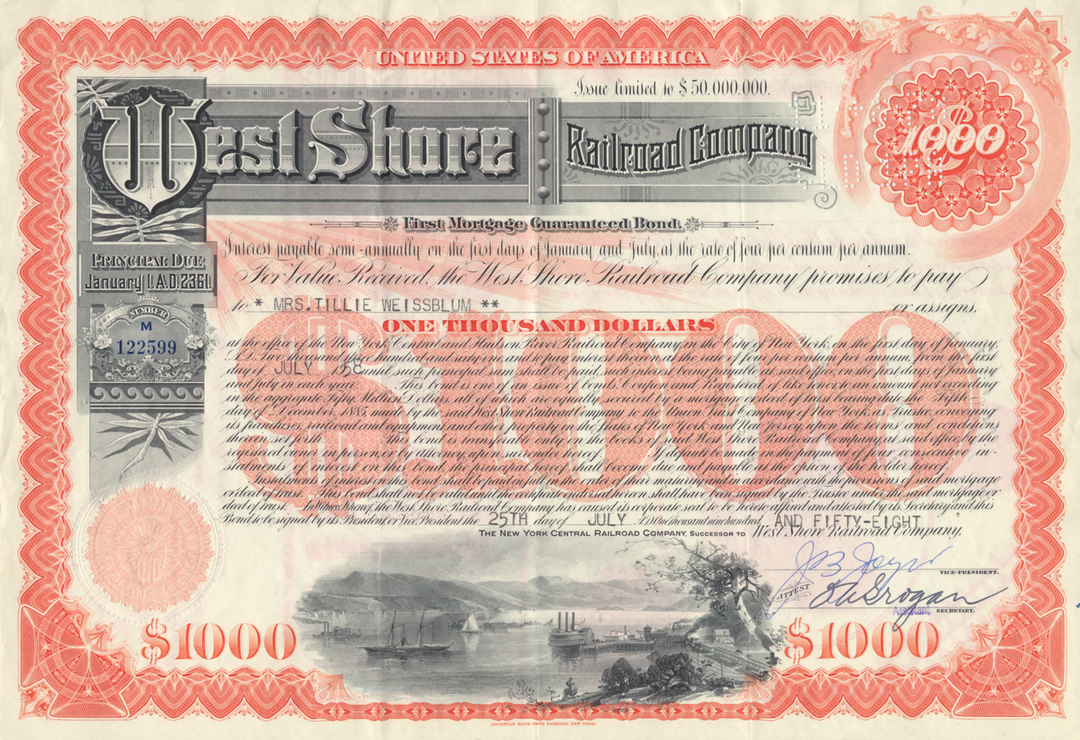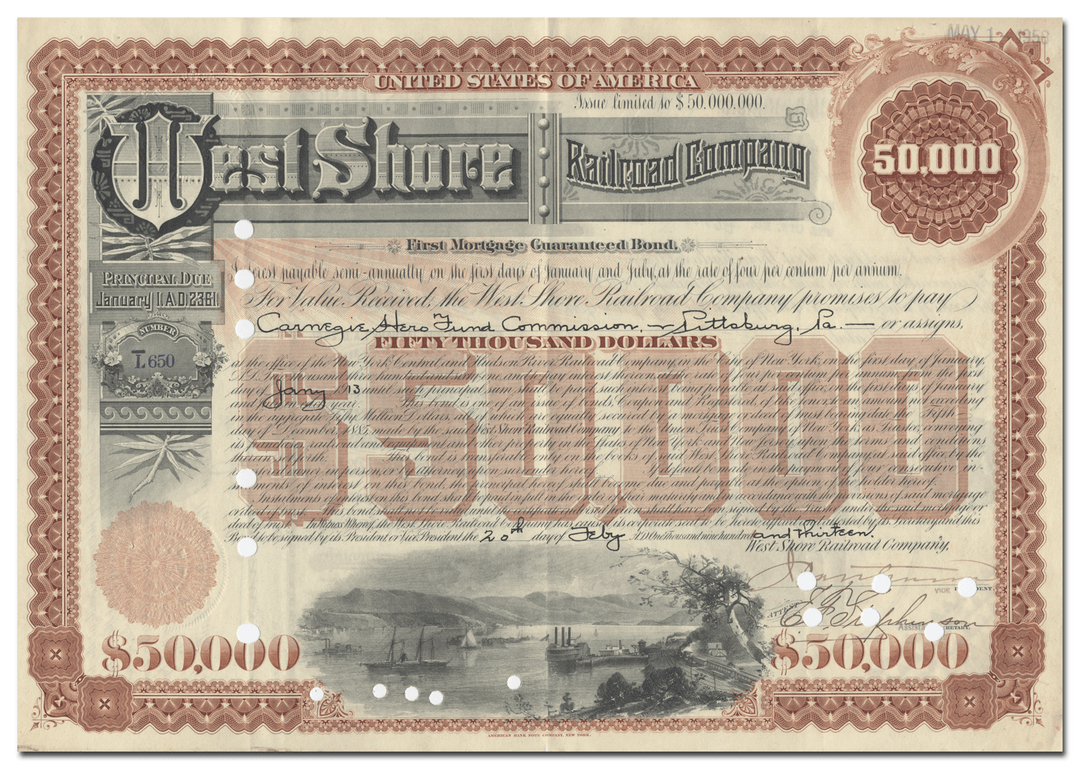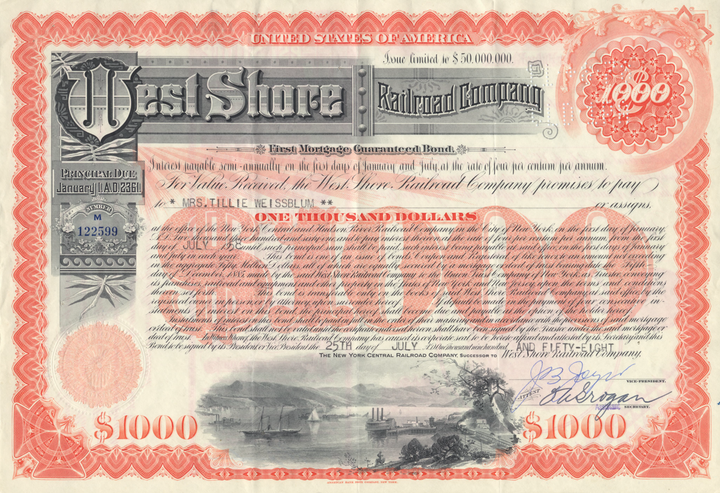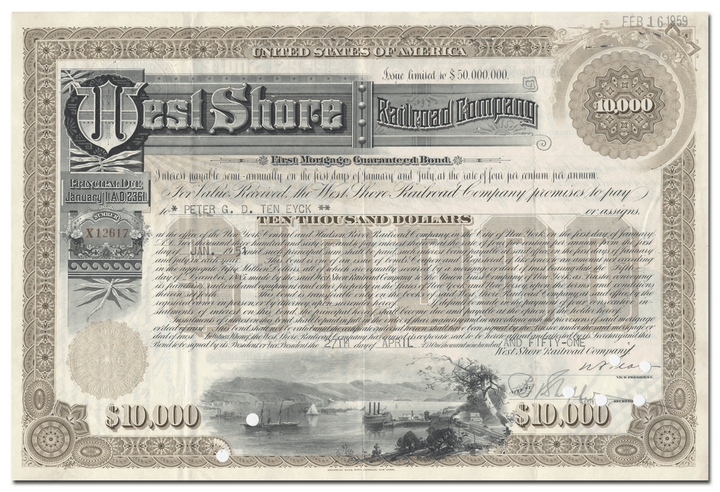West Shore Railroad Company
- Guaranteed authentic document
- Orders over $75 ship FREE to U. S. addresses
Product Details
Company
West Shore Railroad Company
Certificate Type
First Mortgage Bond
Date Issued
1910's, 1950's and 1960's
Canceled
Yes
Printer
American Bank Note Company
Signatures
Hand signed
Approximate Size
14 1/4" (w) by 9 1/2" (h)
Images
Representative of the piece you will receive
Guaranteed Authentic
Yes
Additional Details
NA
Historical Context
The first part of the line was built as the Saratoga and Hudson River Railroad, incorporated April 16, 1864, and opened in Spring 1866. After only about a year of independent operation, the line served as a branch of the New York Central Railroad (NYC), splitting at Athens Junction near Schenectady and running southeast and south along the west side of the Hudson River to Athens, New York. Early plans included acquiring the Saratoga and Schenectady Railroad as a northern extension. The Saratoga and Hudson River was bought and merged into the New York Central as their Athens Branch on September 9, 1867.
The terminal at Athens was destroyed by fire in 1876. The line ran intermittently from then into the 1880s, with its tracks being torn up for good in 1888. It had been called the "White Elephant" Railroad for most of its existence because it quickly outlived whatever usefulness it may have had. Today a row of brick houses known as the Brick Row Historic District which was built in 1850 for the workers of the failed railroad stand in Athens as the only remaining structure related to the "White Elephant" Railroad project.
At the south end of the route, the Ridgefield Park Railroad was incorporated April 4, 1867. This was planned as a branch of the New Jersey Rail Road, splitting at Marion Junction and running north on the west side of the New Jersey Palisades via Ridgefield Park to the state line at Tappan, New York.
Across the state line, the Rockland Central Railroad was incorporated May 23, 1870, to continue the line to Haverstraw, and the Rockland Central Extension Railroad, incorporated May 29, 1872, was to continue further north along the west side of the Hudson River. The Rockland Central and Rockland Central Extension merged on July 29, 1872, to form a new Rockland Central Railroad, and that company merged with the Ridgefield Park to form the Jersey City and Albany Railroad on June 24, 1873, with the intention of building a full line from Jersey City to Albany.
The line first opened in 1872 as a spur of the New Jersey Midland Railway, which had built the section south of Ridgefield Park. At that time, the northern terminus was at Tappan; the extension north to Haverstraw, New York, opened in 1879.
Bankruptcy struck soon, and the New York section of the line was sold on September 28, 1877, and reorganized October 12, 1878, as the Jersey City and Albany Railway. The part in New Jersey was sold August 17, 1878, and reorganized with the same name, and the two companies merged in January 1879 to form a consolidated Jersey City and Albany Railway.
The North River Railway was incorporated April 3, 1880, to extend the line north to Albany with a branch to Schenectady and a connection to the New York, Ontario and Western Railway (O&W) at Cornwall, New York. The North River Railway was consolidated with the Jersey City and Albany on May 5, 1881, to form the North River Railroad, again forming a single planned line between Jersey City and Albany.
The Hudson River West Shore Railroad was incorporated February 16, 1867, and the West Shore Hudson River Railroad was incorporated October 28, 1867, absorbing the Hudson River West Shore on February 16, 1867. This was a second proposed line on the west shore of the river from New Jersey to Albany. The New York, West Shore and Chicago Railroad was incorporated July 13, 1870, and absorbed the West Shore Hudson River on July 21, 1877, with a planned line not only to Albany but then west along the south bank of the Mohawk River to Buffalo. That company was sold and reorganized as the New York, West Shore and Buffalo Railway on February 18, 1880, and on June 14, 1881, the North River Railroad was merged into it, forming one company in charge of the whole route from New Jersey to Buffalo.
In 1883, the newly formed company inaugurated service from Newburgh and Jersey City at the Pennsylvania Railroad Depot, where passengers transferred to ferries across the river.
A new alignment was built along the east side of the New York, Susquehanna and Western Railway (formerly the New Jersey Midland) to North Bergen. By 1886, service operated to Weehawken Terminal through a tunnel under Bergen Hill that had been built in the three preceding years.
The company leased the Athens Branch of the New York Central and Hudson River Railroad, the old Saratoga and Hudson River Railroad, and incorporated it into their main line between Coxsackie and Fullers. At Ravena, along the Athens Branch, the main line turned northwest towards Schenectady, while a new branch continued north to Kenwood Junction on the Albany and Susquehanna Railroad in Albany. This full line formed an immediate threat to the NYC monopoly.
In addition to its owned trackage, the West Shore (WS) also had trackage rights over the Suspension Bridge and Erie Junction Railroad and Erie International Railroad, providing a route from Buffalo to Ontario. After the New York Central took over the West Shore, this was useless, as the New York Central had a parallel line, the Buffalo and Niagara Falls Railroad.
The West Shore also had relations with the Boston, Hoosac Tunnel and Western Railway (BHT&W), which would have run from the Hoosac Tunnel in Massachusetts west to Buffalo. Instead the BHT&W built only to Rotterdam Junction west of Schenectady; it was later taken over by the Fitchburg Railroad.
In 1881, the WS had been planned as a link in a new cross-country line from New York City to San Francisco, using the Nickel Plate Road, Chicago, Milwaukee and St. Paul Railway, Northern Pacific Railroad and Oregon Navigation Company. However, William Henry Vanderbilt of the NYC had bought the Nickel Plate in 1882, killing that plan. The NYC then proceeded to drive the New York, West Shore and Buffalo into bankruptcy.
The Pennsylvania Railroad (PRR) recognized that the WS would make a great addition to their system, allowing them to penetrate deep into NYC territory. At the same time, the NYC was building the South Pennsylvania Railroad across southern Pennsylvania, the Pennsylvania Railroad's territory. The two railroads came to an agreement, where the NYC would buy the WS and stop building the South Pennsylvania (sections of which were later used for the Pennsylvania Turnpike). The NYC bought the New York, West Shore and Buffalo Railway on November 24, 1885, and reorganized their new acquisition as the West Shore Railroad on December 5, leasing it for 475 years from January 1, 1886.
In many sections, the WS ran on a straighter path than the NYC, and was thus used for through freight. For instance, between Oneida and Utica, the WS followed the general line of the never-built Syracuse and Utica Direct Railroad, which had been merged into the NYC.
Several named trains traveled north from Weehawken to Albany included the Storm King Limited and the West Pointer.
Main stops between Albany Union Station and Weehawken Terminal included Ravena, Coxsackie, Catskill, Saugerties, Kingston, Highland, Marlborough, Newburgh, Cornwall, West Point, Haverstraw, Congers, West Nyack, Orangeburg, Tappan, all in New York, and Dumont, Teaneck, Bogota, and Ridgefield Park in New Jersey.
Related Collections
Additional Information
Certificates carry no value on any of today's financial indexes and no transfer of ownership is implied. All items offered are collectible in nature only. So, you can frame them, but you can't cash them in!
All of our pieces are original - we do not sell reproductions. If you ever find out that one of our pieces is not authentic, you may return it for a full refund of the purchase price and any associated shipping charges.











